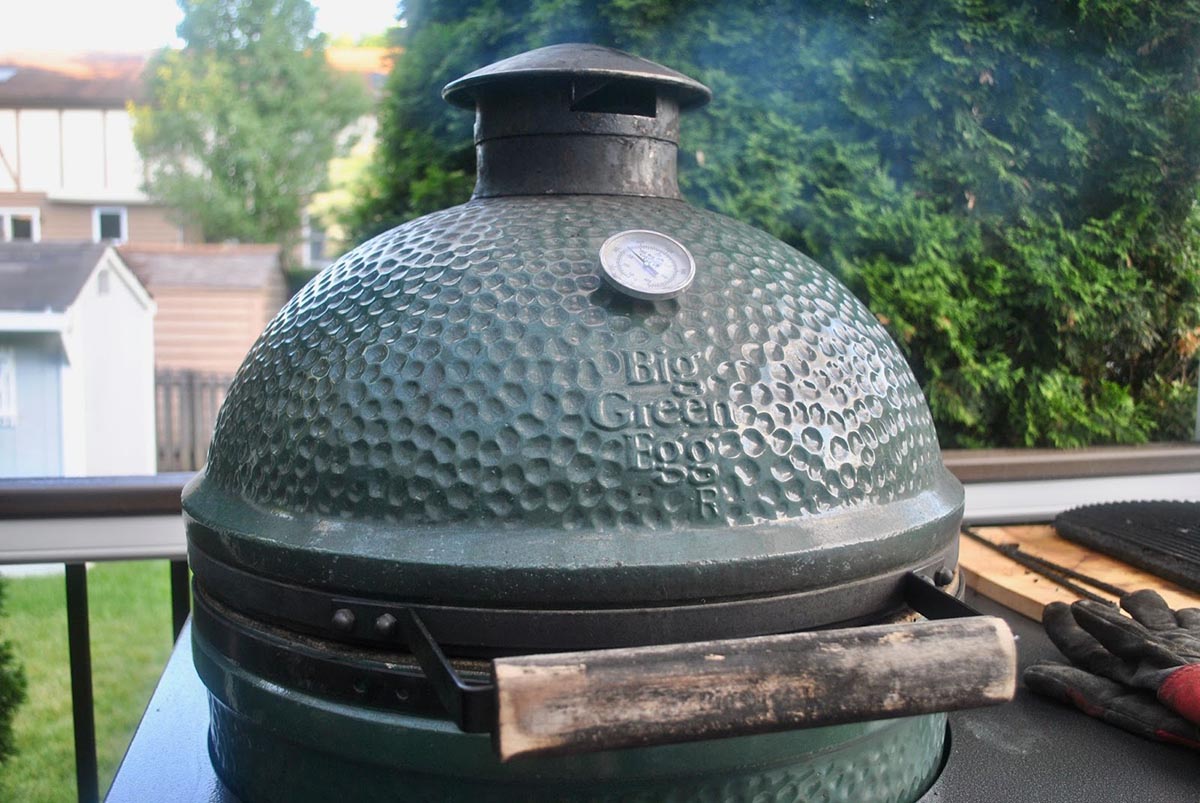

We may earn revenue from the products available on this page and participate in affiliate programs. Learn More ›
No outdoor cooking product seems to have inspired such a loyal following as the Big Green Egg. Every year thousands of Big Green Egg fanatics—AKA Eggheads—gather at Eggfests around the country in a cooking celebration of this glazed ceramic grill. It’s also inspired copycat products (which have yet to garner the same level of devotion, it appears).
Whether that loyalty is due to the Egg’s touted versatility as a grill, a smoker, and an oven—or simply the fact that it’s been around for decades—is not entirely clear.
Regardless, does one product really deserve its own festival? Is the Big Green Egg worth it? My husband, a 20-year grilling veteran, tested the Egg over hours of searing, cooking, and smoking meats to find out if it’s as amazing as Eggheads claim.
Get the large Big Green Egg at Ace Hardware for $999.99
At a Glance
Big Green Egg
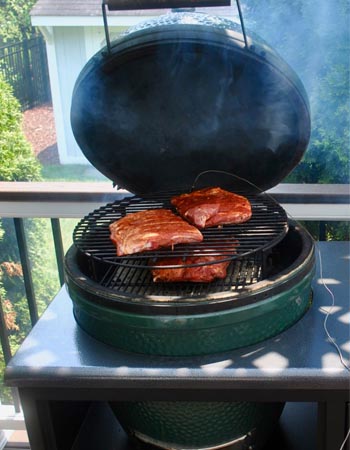
Pros
- Versatile (grills, bakes, smokes)
- Fuel efficient
- Built to last a lifetime
Cons
- High price induces sticker shock
- Weight makes moving difficult
Rating: 8.5/10
What Is the Big Green Egg?
Introduced in 1974, the Big Green Egg is America’s original ceramic grill for outdoor cooking enthusiasts. Its design is based on clay cookers from Japan called kamados, with thick glazed ceramic that insulates this outdoor oven from the elements and creates optimal conditions for cooking a variety of foods.
The Big Green Egg comes in seven sizes: mini; minimax; small; medium; large; extra-large; and extra, extra large. Each air-tight ceramic Egg is glazed with porcelain for exceptional durability and includes a stainless steel cooking grid. A built-in temperature gauge provides precise readings up to 750 degrees. Two vents, a flow draft door at the bottom and a dual-function metal top, adjust to maintain temperature control.
The large Egg, used in testing, boasts a cooking area of 262 square inches across a diameter of 18.25 inches. Of course, most people don’t think about cooking surfaces in square inches, so here’s a more practical spec reference. The large Egg can fit any of these items at one time: one, 20-pound turkey, 12 burgers, six chickens vertically, eight steaks, or seven racks of ribs vertically. In other words, it’s plenty of cooking surface for a weeknight dinner or a weekend get-together. Just don’t plan on moving it anywhere. At 162 pounds, it’s not an on-the-go grill.
The Big Green Egg is slim on included accessories, offering only a standard grill grid and temperature gauge. Perhaps most noticeably, it does not come with a stand, an obvious essential to start cooking on this quality kamado-style grill. (It does come with metal feet, but these do not raise the Egg to a comfortable cooking height.) Neither does it come with a ceramic heat deflector, a necessity for indirect cooking. Other nice-to-have items, such as an ash tool, a weather-proof cover, or a pizza stone must be purchased separately as well. These items and others may come as part of a package depending on the dealer.
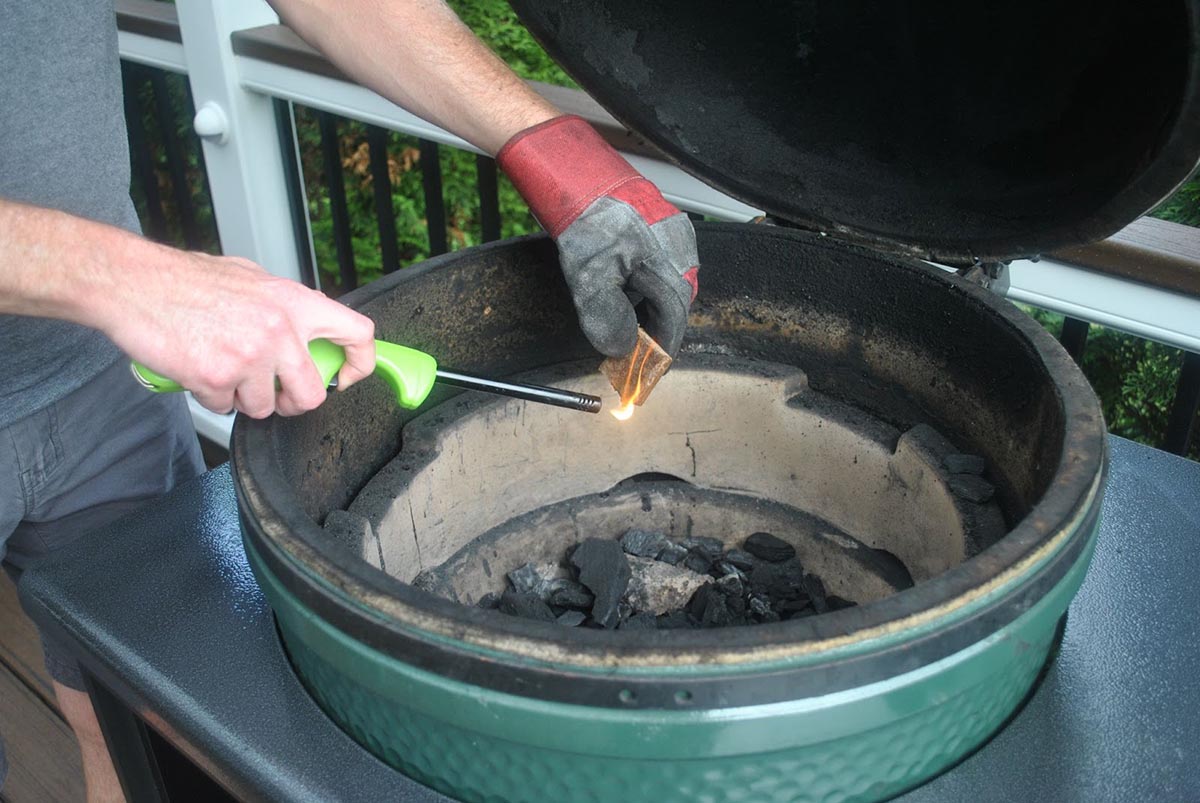
Ease of Use
Cooking on an Egg is fairly straightforward. It involves a small amount of prep, followed by lighting and heating, and then cooling the grill after cooking. For outdoor cooks who’ve used metal charcoal grills, the process should seem very familiar. Once the prep and heating are done the design—the bottom-to-top-airflow and the heat retention of the ceramic—does the majority of work, while the user simply adjusts airflow as necessary to maintain ideal temps.
Prepping the Grill
Before heating up the Egg, the leftover ash should be removed, if needed. It’s necessary to remove ash once every five to ten cooks, which is a bonus for anyone who’s less than enthusiastic about cleaning. Because the Egg doesn’t require a lot of charcoal, another great benefit, it doesn’t accumulate much ash in one cook.
When it’s time to remove the gray matter, just open the screen on the bottom and use an ash tool to scrape it into a dustpan. While special accessories are available, a dustpan works just fine, too. When finished, close the screen, but leave the flow draft door open for heating the grill.
Heating the Grill
Next, scrape the leftover charcoal to one side, making sure all the holes on the fire grate are clear, and pour in the fresh lump of charcoal to the top of the fire box. Then mix the old and new charcoal and make a small well in the center for a natural fire starter. These are generally made from a combination of wood, paper, and wax. Never use lighter fluid when cooking with an Egg. In addition to being unnecessary and laden with chemicals, lighter fluid can seep into the ceramic and leave food with a strange taste.
Finally, light the fire starter and place it in the well. Let it burn for about 20 minutes with the lid open for a high-heat cook. For a low-heat cook, let it burn for about 15 minutes. After the coals heat up, place the grill grid inside, close the dome, and adjust the top and bottom vents as necessary. Put simply, for high-heat cooks, vents should remain mostly open to let in more air, and for low-heat cooks, the vents should be slightly open. Once the interior reaches the desired temp, the Egg becomes a versatile outdoor oven.
Cooling the Grill
When finished cooking, close the dome, close the flow draft door on the bottom, and replace the metal top with the ceramic damper top. This deprives the fire of oxygen to put it out. However, because the Egg holds heat so well, it takes several hours to cool. So, if you cook at night, you have to wait until morning to replace the cover.
Tips on How to Use a Big Green Egg
Cooking with the Big Green Egg is generally not too complicated, but there is a bit of a learning curve. While some may consider that a con to owning this product, others may just consider it part of the outdoor cooking experience, and a way to perfect their cooking skills and recipes. Here are a few things to keep in mind when cooking with an Egg:
- Do not cook at temperatures higher than 350 degrees for the first few uses. This allows the gasket to fully cure and create a seal.
- Burp the Egg. Burping means to open the Egg an inch or two and pause before opening the dome completely. This allows air to enter the dome slowly and prevents flare-ups—and burns. Burp the Egg every time the dome is opened during cooking.
- Stay near the Egg when heating the grill to keep an on the temperature gauge. The Egg heats up fast. If it gets hotter than desired, there’s a quick fix. Close the flow draft door and the dual-function metal top, to decrease airflow and tame the heat. Then readjust them once the grill reaches the desired temp.
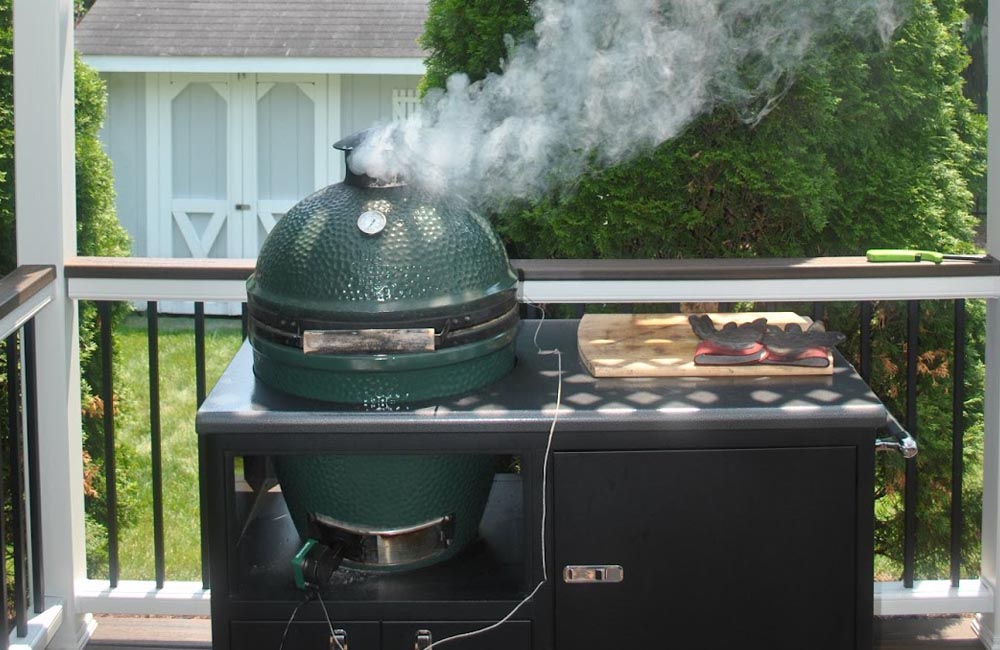
Big Green Egg Assembly
At a substantial 162 pounds, assembling a large Big Green Egg requires at least two people. The weight alone made us wary of attempting assembly. Although it comes with a manual, and various how-to videos abound on the web, we were able to get professional assembly included with our purchase. However, even if we had been charged for assembly, it would have been a small price to pay given what we had already spent on the Egg and its accessories. What’s more, professional assembly allowed us to get cooking even quicker.
Two hardware store employees delivered and assembled our Egg in less than 30 minutes, a fraction of the time we would have spent putting it together. Our recommendation: get experts to assemble your Egg.
Features and Versatility
The Big Green Egg’s most notable feature is its ability to efficiently cook flavorful food. It does not require much charcoal to start and old lump charcoal can be reused for future cooks. In addition, the ceramic’s superior heat retention allows users to cook several items over the course of a few hours or to cook large items for a long, slow cook. It’s great for make-ahead meal-planning. The Egg fits the bill for efficiency.
It’s also a very versatile cooker, able to sear, roast, bake, and smoke all in one. However, to really capture the advantages of its versatility, extra accessories, such as a pizza stone, tiered grill grates, and a heat deflector, are must-haves. Without these accessories, harnessing the Egg’s versatility isn’t possible.
Adding several accessories over the long term is always an option with the Egg, however. Its durable design ensures that it will last for many years, so much so that the manufacturer offers a limited lifetime warranty.
Big Green Egg Cost
One of the Big Green Egg’s obvious cons is price. At $999.99 for the grill, it may not be a price many consumers are willing to pay. Plus, additional accessories add up fast, and many of them are needed to get started and take advantage of everything the Egg can do. So what’s a financially frustrated outdoor cook to do? Contact a local Big Green Egg retailer for sale prices and package deals. Offers vary by store.
While the price is high, Big Green Eggs do have a lifetime limited warranty on all the ceramic components, including the dome, base, damper top, fire box, and fire ring. My husband has had his Egg for 9 years and doesn’t expect to need to make a warranty claim at any point.
In those 9 years, he has spent very little on upkeep. Maintaining his Egg has amounted to emptying ashes, cleaning grates, and wiping down ceramic inserts, such as the heat deflector and pizza stone. Beyond this regular maintenance, we’ve had to replace the gasket once every couple of years at a cost of about $30.
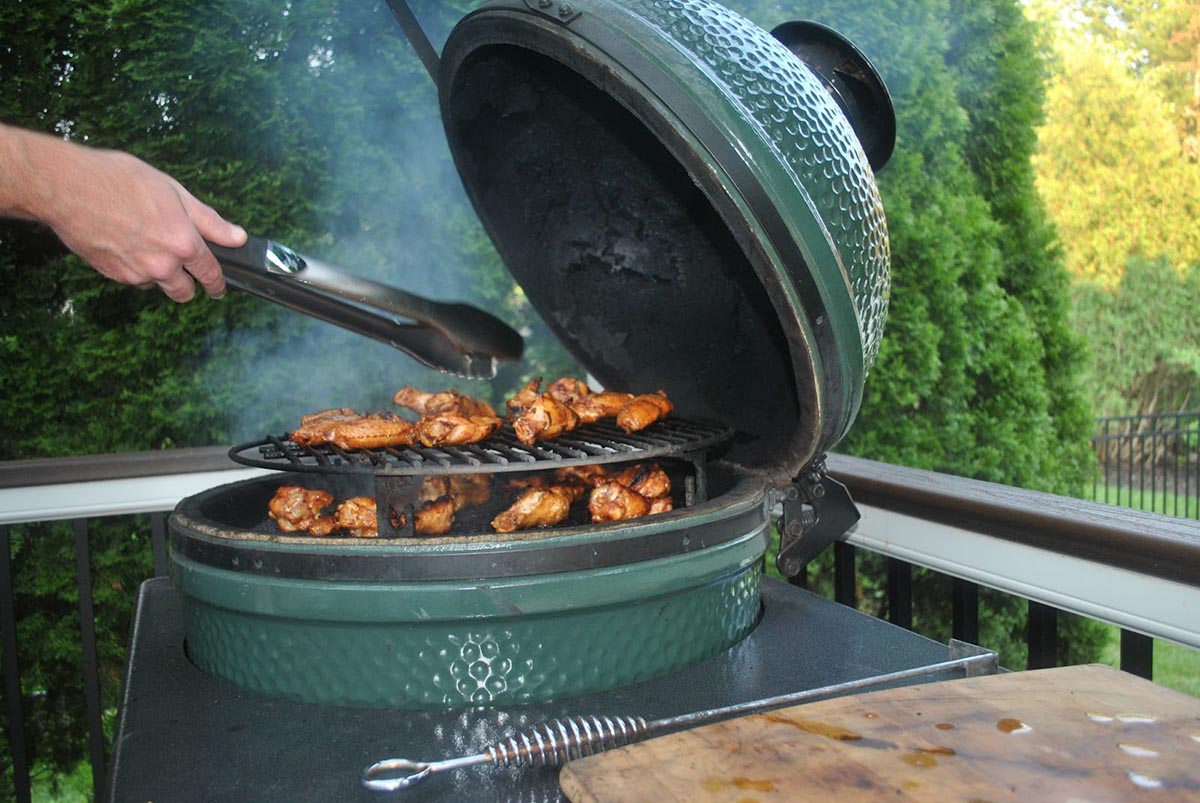
How We Tested the Big Green Egg
My husband, a grilling hobbyist for more than 20 years and Big Green Egg owner for 9 of those years, tested the Egg’s cooking capabilities and assessed its ease of use and maintenance. He has used everything from portable grills on cramped city decks to standard gas grills. His love of grilling and barbecue led him to the Big Green Egg, and he hasn’t looked at any other charcoal grills or smokers since.
For testing, he first focused on some of his favorite ways to use the Egg: direct heat searing for porterhouse steaks at 650 degrees, indirect heat for chicken wings at 500 degrees, and smoking St. Louis-style pork ribs at 250 degrees. Using different types of protein as well as different cooking styles highlighted an oft-touted feature of the Egg: its versatility in cooking a lot of great food.
For the steaks, he was able to develop a restaurant-quality char thanks to intensely high heat. He had similar results with the chicken wings. The skin was so crispy, that you’d swear they were fried. Finally, the ribs, which he cooked low and slow with hickory and pecan wood, formed pink smoke rings on the inside, just as though they came from a BBQ stand.
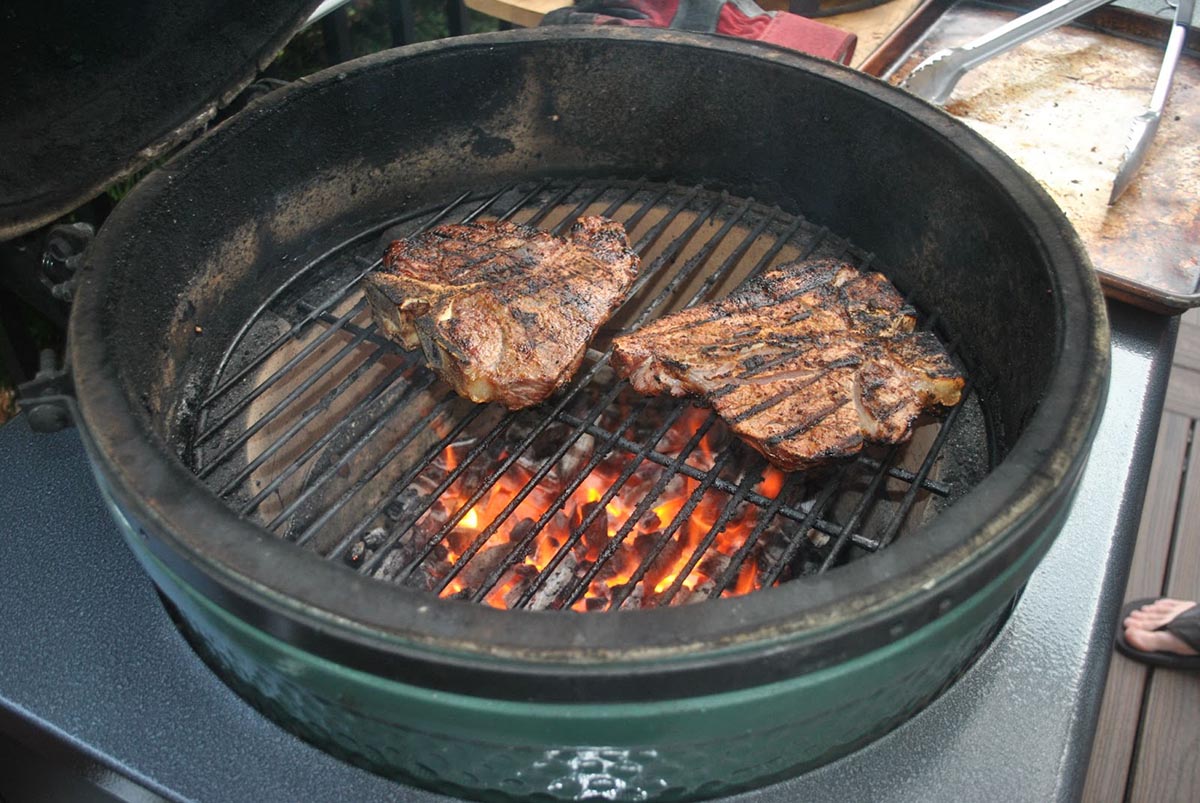
In addition to checking out its cooking chops, he assessed its ease of use. While the heating and cooking process should be fairly straightforward for anyone, for those who have used metal charcoal grills in particular, a transition to the Egg should be quite easy. The Egg’s general design, a domed cooker with vents on the top and bottom, is similar to a metal charcoal grill, and the heating process is also similar.
Finally, he looked at clean-up and maintenance. He has found regular clean-up- and maintenance for the Big Green Egg has been easy, and, again, would be a very familiar process for those with some charcoal grill experience. As previously mentioned, cleaning and maintenance amounts to clearing ash, and cleaning grids and inserts. It’s a few minutes of work that’s more than manageable.
Long-term maintenance, namely gasket replacement, he’s found to be mildly annoying; however, it’s tolerable maintenance, given that it’s inexpensive DIY and only has to be done every few years. Beyond this, he’s only encountered one minor hiccup. Over the years, his Egg has developed a very slight overbite. This is when the dome is no longer perfectly aligned with the base. Fixing it requires adjusting the substantial spring that connects the dome and base. Given that this slight imperfection does not affect the function of the Egg, he has not attempted to fix it and has no plans to do so.
Is Big Green Egg Right for You?
The Big Green Egg is for outdoor cooking enthusiasts. To truly enjoy the Egg, you have to not only revel in the tasty results but also in the cooking process. Whether it’s figuring out the optimal vent positions for the perfect temp or figuring out preferred wood chips for smoking, the process is part of the joy of this cooking experience. So while the Big Green Egg delivers a variety of delicious dishes, home cooks who like to set it and forget it probably won’t see the value in the versatile vessel.
In addition to producing great food and providing an engaged cooking process, the Big Green Egg cooks efficiently. Its superior heat retention reduces the need for large quantities of charcoal. Plus, mixing the old and new charcoal further reduces fuel waste. It also eliminates the need for several outdoor cooking contraptions. It can do the work of a gas grill, charcoal grill, a smoker, and a pizza oven, so there’s no need for a gas tank, lighter fluid, charcoal briquets, or electricity. Perhaps what makes it most efficient is that it has a limited lifetime warranty. It’s designed and built to last a long time.
If you don’t intend to move an Egg often, can deal with minor maintenance, and can surmount the initial sticker shock, you’ll have a lot of fun with it—and probably savor more than your share of great meals, too.
Where to Buy the Big Green Egg
The Big Green Egg is available on Big Green Egg, and at many local hardware and outdoor specialty stores, including Ace Hardware. Contact local retailers for more information on sales and package deals.
Get the Big Green Egg at Ace Hardware for $999.99.
Meet the Tester
As an Editor at BobVila.com, Beth Cranston designs the testing guidelines and rubrics for the product reviews team. She has been a writer and editor for over a decade, with a focus on all things home since 2017, covering everything from kitchen design ideas to electrical plans. An avid home cook, she believes that everyone should know how to reverse sear, that deglazing is the best way to clean a pan, and that no appliance should collect dust.
